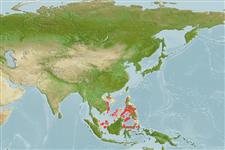Teleostei (teleosts) >
Blenniiformes (Blennies) >
Tripterygiidae (Triplefin blennies) > Tripterygiinae
Etymology: Helcogramma: Greek, helkos, -eos, -ous = ulcer, sore + Greek, gramma = letter, mark (Ref. 45335); desa: The specific epithet is derived from the Latin "desa", meaning neglected. The name refers to the fact that this species has been overlooked in previous studies of the group. The name is treated as Noun in apposition.
Environment: milieu / climate zone / depth range / distribution range
Ecology
Marine; benthopelagic; depth range 0 - 7 m (Ref. 52308). Tropical
Western Pacific: Philippines and Viet Nam.
Size / Weight / Age
Maturity: Lm ? range ? - ? cm
Max length : 5.5 cm TL male/unsexed; (Ref. 90102)
Short description
Identification keys | Morphology | Morphometrics
Dorsal spines (total): 17 - 18; Dorsal soft rays (total): 11 - 13; Anal spines: 1; Anal soft rays: 20 - 21. A species of Helcogramma (sensu Hansen, 1986) with 2 symphisial mandibular sensory pores, second dorsal fin spines XIV (three specimens with XV), third dorsal fin segmented rays 10-11, last ribs on vertebral centrum 10-11, vertebrae modally 10+28=38, pored lateral line scales modally 22 or 23, nape scales present, males with dusky anal fin.
Body shape (shape guide): elongated.
Adults are found at depths of 7 m and shallower, in surge channels and exposed coasts of rocky boulders (Ref. 90102). Eggs are hemispherical and covered with numerous sticky threads that anchor them in the algae on the nesting sites (Ref. 240). Larvae are planktonic which occur primarily in shallow, nearshore waters (Ref. 94114).
Life cycle and mating behavior
Maturity | Reproduction | Spawning | Eggs | Fecundity | Larvae
Williams, J.T. and J.C. Howe, 2003. Seven new species of the triplefin fish genus Helcogramma (Tripterygiidae) from the Indo-Pacific. aqua, J. Ichthyol. Aquat. Biol. 7(4):151-176. (Ref. 52308)
IUCN Red List Status (Ref. 130435: Version 2025-1)
Threat to humans
Harmless
Human uses
Tools
Special reports
Download XML
Internet sources
Estimates based on models
Preferred temperature (Ref.
123201): 27.6 - 29.2, mean 28.8 °C (based on 346 cells).
Phylogenetic diversity index (Ref.
82804): PD
50 = 0.5000 [Uniqueness, from 0.5 = low to 2.0 = high].
Bayesian length-weight: a=0.00617 (0.00288 - 0.01322), b=3.04 (2.86 - 3.22), in cm total length, based on LWR estimates for this (Sub)family-body shape (Ref.
93245).
Trophic level (Ref.
69278): 3.1 ±0.3 se; based on size and trophs of closest relatives
Resilience (Ref.
120179): High, minimum population doubling time less than 15 months (Preliminary K or Fecundity.).
Fishing Vulnerability (Ref.
59153): Low vulnerability (10 of 100).
🛈
